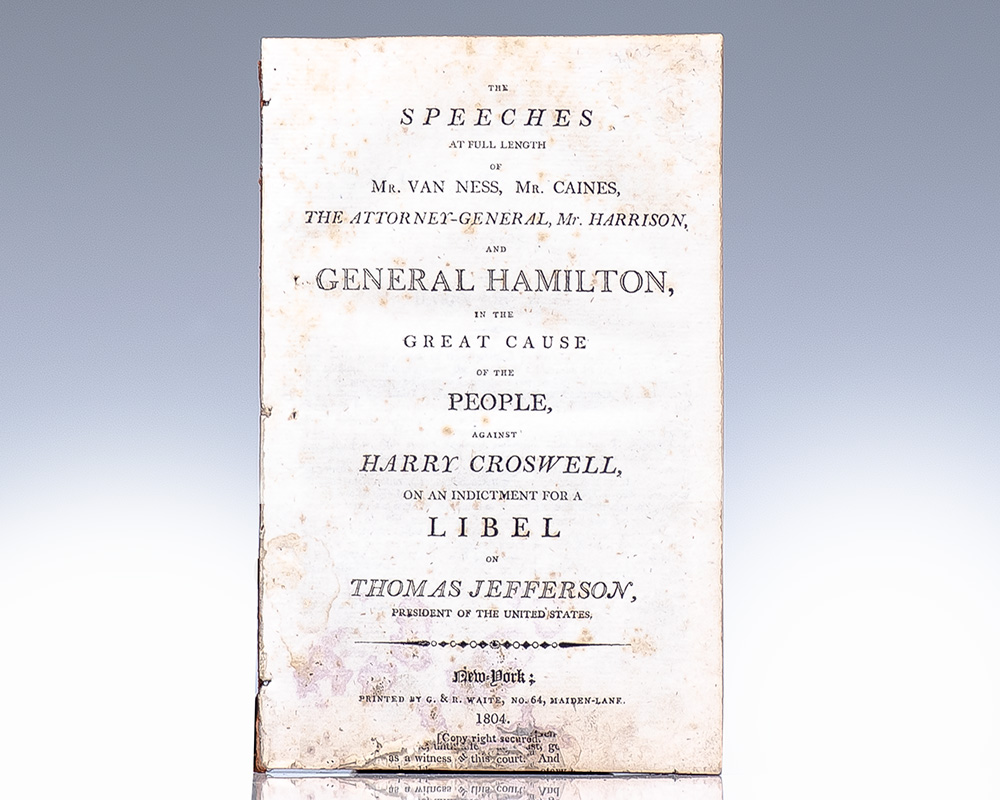Sundry Estimates and Statements Relative to Appropriations for the Service of the Year 1794.
Rare Sundry Estimates and Statements Relative to Appropriations for the Service of the Year 1794
Sundry Estimates and Statements Relative to Appropriations for the Service of the Year 1794.
HAMILTON, Alexander.
$12,500.00
Item Number: 132301
Rare printed Treasury Department report detailing projected expenditures by the federal government for the year 1794. Quarto, 20 pp. Includes reporting on sources of revenue, duties on imports and tonnage, provision for payment of interest on balances due to the individual states, as well as interest on the public debt. Also printed is expenditures for the Civil List for the various branches and departments of the federal government, including the executive, both houses of Congress, the War Department, Indian Department, etc. Finally, printed toward the rear is a list of the revenue and appropriations for 1789-93, the amount of duties and tonnage accrued from January-June 1793, and monies transferred to the United States out of the proceeds from foreign loans. In very good condition. Rare with only one example appearing at auction in the last 80 years.
At the inauguration of the constitutional government in 1789 Alexander Hamilton (1757- 1804), George Washington's former military aide and a renowned financier, was appointed the first Secretary of the Treasury and thus he became the architect of the structure of the Department. Desirous of a strong, centrally controlled Treasury, Hamilton did constant battle with Thomas Jefferson, then Secretary of State, and Albert Gallatin, then a Congressman, over the amount of power the Department of the Treasury should be allowed to wield. He designed a Treasury Department for the collection and disbursing of public revenue, but also for the promotion of the economic development of the country. Facing a chaotic treasury burdened by the heavy debt of the Revolutionary War, Hamilton's first interest when he took office was the repayment of the war debt in full. "The debt of the United States ... was the price of liberty,'' he affirmed, and he then put into effect, during 1790 and 1791, a revenue system based on customs duties and excise taxes. Hamilton's attack on the debt helped secure the confidence and respect of foreign nations. He introduced plans for the First Bank of the United States, established in 1791 which was designed to be the financial agent of the Treasury Department. The Bank served as a depository for public funds and assisted the Government in its financial transactions. The First Bank issued paper currency, used to pay taxes and debts owed to the Federal Government. Hamilton also introduced plans for a United States Mint. Though he wanted the Mint to be a structural part of the Treasury, he lost the battle to Jefferson and it was established in 1792 within the State Department. The Mint became an independent agency in 1797 and was eventually transferred to Treasury in 1873. Under personal financial pressure, his office paying only $3500 a year, Hamilton resigned in 1795 and joined the New York bar. He kept in close contact with President Washington, however, and continued to give financial advice to his successor, Oliver Wolcott. Hamilton was killed in 1804 in a duel with Aaron Burr arising from a political dispute. "Report to the House of Representatives. Treasury Department December 23, 1793. Alexander Hamilton, Secretary of the Treasury". Signatures: [A]2, B-E2. Lacks pp, 22-26, i.e. G2, H1. Evans 26349. (Princeton University collation: [A]2, B-E2, G2, H1 verso blank, noting folded leaf inserted between p. 20 and 22.







